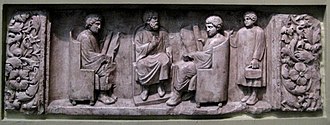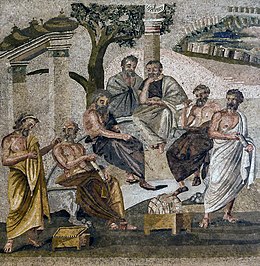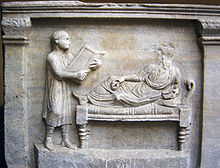
Literacy and education in the Roman Empire contributed to the social mobility that characterized the earlier period of Imperial history known as the Principate. Estimates of the average literacy rate in the Empire range from 5 to 30 percent or higher, depending in part on the definition of "literacy".[1] Full literacy was uncommon, but written documents were ubiquitous, and they were used by a wider range of people in the Roman Imperial world than was typical of most ancient societies.[2] Numeracy was necessary to participate in commerce, and papyri preserve complex accounting methods.[3] Despite the high value Romans placed on writing, education was available only for those who could pay for it, since there was no state-supported system of schools with public funding.
A higher rate of literacy is indicated among military personnel than within the general population. Educated women were not unusual, and there was an expectation that upper-class girls would at least attend primary school, probably in the same classes as boys. Only an elite few, regardless of gender, went on to receive a secondary education.
A significant if modest number of slaves were educated, and slaves played a key role in promoting education and the culture of literacy.[4] Teachers, scribes, and secretaries were likely to be slaves. The education of slaves was not discouraged, and slave-children might attend classes with the children of their masters. Educated slaves seem to have been more likely to be manumitted, and to achieve material prosperity as freedmen. The Classical poet Horace, whose work the emperor Augustus brought to prominence, was the son of a freedman.
Bookstores were already well-established in Rome by the beginning of the Imperial period, and are found also in urban centers of the provinces. Books were expensive, but by the later period, popular genres of literature indicate reading for pleasure among non-elites. Emperors sponsored libraries that were to some extent public, and a wealthy individual might endow a library for a community, or amass impressive private collections to which in-house scholars might be attached. A shift from books in rolled form to books with a spine coincides with the rise of Christian literature. Literacy is thought to have declined in late antiquity during the transition away from the Classical institutions and practices that supported it.
Importance of the written word
The Roman obsession with documents and public inscriptions indicates the high value placed on the written word.[5] Clifford Ando has posed the question as "What good would 'posted edicts' do in a world of low literacy?"[6] Of the total output of written materials, only a tiny portion survives. Papyri are preserved mainly in the favorable conditions of Egypt and the Near East. Writing tablets such as those from Vindolanda in Roman Britain,[7]
Funerary inscriptions on stone are found even for people of humble status, including slaves.
instrumenta domestica are any portable objects that may be inscribed. These include inscriptions on amphorae; brick stamps, plumbing stamps, and tile stamps
The 'epigraphic habit'
Text inscribed on stone or metal and displayed publicly is one of the uses of literacy that is most characteristic of antiquity.[8] The Roman port city of Ostia Antica alone has yielded more than 3,000 inscriptions.[9]
Government and law
The Imperial bureaucracy was so dependent on writing that the Babylonian Talmud declared "if all seas were ink, all reeds were pen, all skies parchment, and all men scribes, they would be unable to set down the full scope of the Roman government's concerns."[10] Laws and edicts were posted in writing as well as read out. Illiterate Roman subjects would have someone such as a government scribe (scriba) read or write their official documents for them.[11]
[law docs] Depending on political perspective, the proliferation of legal documents on behalf of ordinary subjects of the Empire may be viewed as a form of excessive government control or as a means for citizens to participate and assert themselves.[12]
Military literacy

The military produced a vast amount of written reports and service records,[13] and literacy in the army was "strikingly high".[14]
Casual literacy among soldiers is indicated by such practices as inscribing sling bullets with aggressive messages.[15]
Religion and ritual
Although the Romans were not a "People of the Book", they had an extensive priestly archive, and inscriptions appear throughout the Empire in connection with statues and small votives dedicated by ordinary people to divinities, as well as on binding tablets and other "magic spells", with hundreds of examples collected in the Greek Magical Papyri.[16] Religious ceremonies were ways to communicate imperial ideology regardless of ability to read.[17]
Casual literacy
Urban graffiti, which include literary quotations, and low-quality inscriptions with misspellings and solecisms indicate casual literacy among non-elites.[18] Political slogans and obscenities are widely preserved as graffiti in Pompeii.[19]
Multilingualism and literacy
For a case study of a specific region in the Western provinces, see Curchin, "Literacy in the Roman Provinces", especially p. 473.
Literacy and social values
In Latin, illiteratus (Greek agrammatos) could mean both "unable to read and write" and "lacking in cultural awareness or sophistication."[20] Higher education promoted career advancement, particularly for an equestrian in Imperial service: "eloquence and learning were considered marks of a well-bred man and worthy of reward".[21] The poet Horace, for instance, was given a top-notch education by his father, a prosperous former slave.[22]
Urban elites throughout the Empire shared a literary culture embued with Greek educational ideals (paideia).[23] Hellenistic cities sponsored schools of higher learning as an expression of cultural achievement.[24] Young men from Rome who wished to pursue the highest levels of education often went abroad to study rhetoric and philosophy, mostly to one of several Greek schools in Athens. The curriculum in the East was more likely to include music and physical training along with literacy and numeracy.[25] On the Hellenistic model, Vespasian endowed chairs of grammar, Latin and Greek rhetoric, and philosophy at Rome, and gave teachers special exemptions from taxes and legal penalties, though primary schoolmasters did not receive these benefits. Quintilian held the first chair of grammar.[26] In the eastern empire, Berytus (present-day Beirut) was unusual in offering a Latin education, and became famous for its school of Roman law.[27] The cultural movement known as the Second Sophistic (1st–3rd century AD) promoted the assimilation of Greek and Roman social, educational, and aesthetic values, and the Greek proclivities for which Nero had been criticized were regarded from the time of Hadrian onward as integral to Imperial culture.[28]
Numeracy
Nonverbal communication
Imperial ideology might be communicated non-verbally through public art.[30]
Gesture was a crucial part of rhetorical training.
An early form of story ballet (pantomimus) was brought to Rome by Greek performers and became popular throughout the multilingual Empire in part because it relied on gesture rather than verbal expression.[31]
Schooling
Primary education

Traditional Roman education was moral and practical. Stories about great men and women, or cautionary tales about individual failures, were meant to instill Roman values (mores maiorum). Parents and family members were expected to act as role models, and parents who worked for a living passed their skills on to their children, who might also enter apprenticeships for more advanced training in crafts or trades.[33] Formal education was available only to children from families who could pay for it, and the lack of state intervention in access to education contributed to the low rate of literacy.[34]
Young children were attended by a pedagogus, or less frequently a female pedagoga, usually a Greek slave or former slave.[35] The pedagogue kept the child safe, taught self-discipline and public behavior, attended class and helped with tutoring.[36] The emperor Julian recalled his pedagogue Mardonius, a eunuch slave who reared him from the age of 7 to 15, with affection and gratitude.[37] Usually, however, pedagogues received little respect.[38]
Primary education in reading, writing, and arithmetic might take place at home for privileged children whose parents hired or bought a teacher.[39] Others attended a school that was "public," though not state-supported, organized by an individual schoolmaster (ludimagister) who accepted fees from multiple parents.[40] Vernae (homeborn slave children) might share in home- or public-schooling.[41] Schools became more numerous during the Empire, and increased the opportunities for children to acquire an education.[42] School could be held regularly in a rented space, or in any available public niche, even outdoors. Boys and girls received primary education generally from ages 7 to 12, but classes were not segregated by grade or age.[43] For the socially ambitious, bilingual education in Greek as well as Latin was a must.[42]
Quintilian provides the most extensive theory of primary education in Latin literature. According to Quintilian, each child has in-born ingenium, a talent for learning or linguistic intelligence that is ready to be cultivated and sharpened, as evidenced by the young child's ability to memorize and imitate.[44] The child incapable of learning was rare.[45] To Quintilian, ingenium represented a potential best realized in the social setting of school, and he argued against homeschooling.[45] He also recognized the importance of play in child development,[46] and disapproved of corporal punishment because it discouraged love of learning—in contrast to the practice in most Roman primary schools of routinely striking children with a cane (ferula) or birch rod for being slow or disruptive.[47]
The Jewish historian Josephus (1st century AD) asserted that the education of children was a foremost concern of Jewish families. Reading was necessary to know the Torah and observe the law, but an advanced ability to write was a specialized scribal skill.[48] The conditions of literacy for Jewish families and within the Roman Empire as a whole contribute to questions about whether Jesus of Nazareth would have been able to read and write.[49]
Secondary and higher education

At the age of 14, upperclass males made their rite of passage into adulthood, and began to learn leadership roles in political, religious, and military life through mentoring from a senior member of their family or a family friend.[50] Higher education was provided by grammatici or rhetores.[51] The grammaticus or "grammarian" taught mainly Greek and Latin literature, with history, geography, philosophy or mathematics treated as explications of the text.[52] With the rise of Augustus, contemporary Latin authors such as Vergil and Livy also became part of the curriculum.[53] The rhetor was a teacher of oratory or public speaking. The art of speaking (ars dicendi) was highly prized as a marker of social and intellectual superiority, and eloquentia ("speaking ability, eloquence") was considered the "glue" of a civilized society.[54] Rhetoric was not so much a body of knowledge (though it required a command of references to the literary canon[55]) as it was a mode of expression and decorum that distinguished those who held social power.[56] The ancient model of rhetorical training—"restraint, coolness under pressure, modesty, and good humor"[57]—endured into the 18th century as a Western educational ideal.[58]
Educated women

Literate women ranged from cultured aristocrats to girls trained to be calligraphers and scribes.[59] The "girlfriends" addressed in Augustan love poetry, although fictional, represent an ideal that a desirable woman should be educated, well-versed in the arts, and independent to a frustrating degree.[60] Education seems to have been standard for daughters of the senatorial and equestrian orders during the Empire.[41] A highly educated wife was an asset for the socially ambitious household, but one that Martial regards as an unnecessary luxury.[61]
The woman who achieved the greatest prominence in the ancient world for her learning was Hypatia of Alexandria, who educated young men in mathematics, philosophy, and astronomy, and advised the Roman prefect of Egypt on politics. Her influence put her into conflict with the bishop of Alexandria, Cyril, who may have been implicated in her violent death in 415 at the hands of a Christian mob.[62]
Education of slaves

Slaves were numerate and literate in small but significant numbers, and some were highly educated.[63] Vernae (homeborn slave children) might share in home- or public-schooling.[64]
A skilled slave copyist (servus litteratus) could be valued as highly as 100,000 sesterces.[65]
Book culture
Books were expensive, since each copy had to written out individually on a roll of papyrus (volumen) by scribes who had apprenticed to the trade.[66] The codex—a book with pages bound to a spine—was still a novelty in the time of the poet Martial (1st century AD),[67] but by the end of the 3rd century was replacing the volumen[68] and was the regular form for books with Christian content.[69] Commercial production of books had been established by the late Republic,[70] and by the 1st century AD certain neighborhoods of Rome were known for their bookshops (tabernae librariae), which were found also in Western provincial cities such as Lugdunum (present-day Lyon, France).[71] The quality of editing varied wildly, and some ancient authors complain about error-ridden copies,[72] as well as plagiarism or forgery, since there was no copyright law.[73]

Collectors amassed personal libraries,[74] such as that of the Villa of the Papyri in Herculaneum, and a fine library was part of the cultivated leisure (otium) associated with the villa lifestyle.[75] Significant collections might attract "in-house" scholars; Lucian mocked mercenary Greek intellectuals who attached themselves to philistine Roman patrons.[76] An individual benefactor might endow a community with a library: Pliny the Younger gave the city of Comum a library valued at 1 million sesterces, along with another 100,000 to maintain it.[77] Imperial libraries housed in state buildings were open to users as a privilege on a limited basis, and represented a literary canon from which disreputable writers could be excluded.[78] Books considered subversive might be publicly burned,[79] and Domitian crucified copyists for reproducing works deemed treasonous.[80]
Literary texts were often shared aloud at meals or with reading groups.[81] Scholars such as Pliny the Elder engaged in "multitasking" by having works read aloud to them while they dined, bathed or traveled, times during which they might also dictate drafts or notes to their secretaries.[82] The multivolume Attic Nights of Aulus Gellius is an extended exploration of how Romans constructed their literary culture.[83] The reading public expanded from the 1st through the 3rd century, and while those who read for pleasure remained a minority, they were no longer confined to a sophisticated ruling elite, reflecting the social fluidity of the Empire as a whole and giving rise to "consumer literature" meant for entertainment.[84] Illustrated books, including erotica, were popular, but are poorly represented by extant fragments.[85]
Decline of literacy
Literacy began to decline, perhaps dramatically, during the socio-political crisis of the 3rd century.[86] Although the Church Fathers were well-educated, they regarded Classical literature as dangerous, if valuable, and reconstrued it through moralizing and allegorical readings. Julian, the only emperor after the conversion of Constantine to reject Christianity, banned Christians from teaching the Classical curriculum, on the grounds that they might corrupt the minds of youth.[87]
While the book roll had emphasized the continuity of the text, the codex format encouraged a "piecemeal" approach to reading by means of citation, fragmented interpretation, and the extraction of maxims.[88] In the 5th and 6th centuries, reading became rarer even for those within the Church hierarchy.[89]